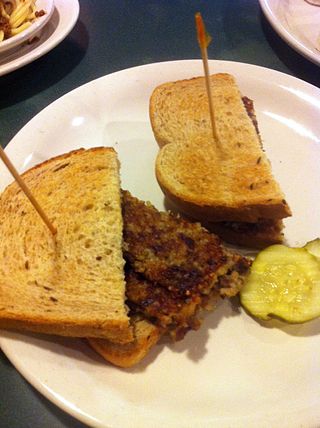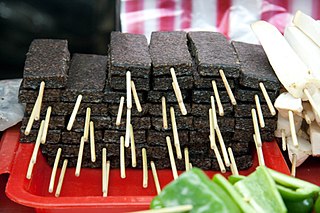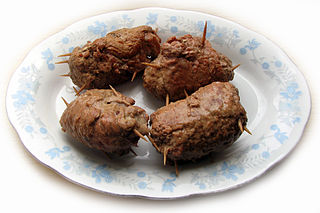
A sausage is a type of meat product usually made from ground meat—often pork, beef, or poultry—along with salt, spices and other flavourings. Other ingredients, such as grains or breadcrumbs, may be included as fillers or extenders.

Head cheese or brawn is a cold cut terrine or meat jelly that originated in Europe. It is made with flesh from the head of a calf or pig, typically set in aspic, and usually eaten cold, at room temperature, or in a sandwich. Despite its name the dish is not a cheese and contains no dairy products. The parts of the head used vary, and may include the tongue but do not commonly include the brain, eyes or ears. Trimmings from more commonly eaten cuts of pork and veal are often used, and sometimes the feet and heart, with gelatin added as a binder.

Tripe is a type of edible lining from the stomachs of various farm animals. Most tripe is from cattle, pigs and sheep.

A blood sausage is a sausage filled with blood that is cooked or dried and mixed with a filler until it is thick enough to solidify when cooled. Most commonly, the blood of pigs, sheep, lamb, cow, chicken, or goose is used.

Offal, also called variety meats, pluck or organ meats, is the internal organs of a butchered animal. The word does not refer to a particular list of edible organs, and these lists of organs vary with culture and region, but usually exclude skeletal muscle. Offal may also refer to the by-products of milled grains, such as corn or wheat.

Polish cuisine is a style of food preparation originating in and widely popular in Poland. Due to Poland's history, Polish cuisine has evolved over the centuries to be very eclectic, and shares many similarities with other national cuisines. Polish cooking in other cultures is often referred to as à la polonaise.

Pierogi or pierogies are filled dumplings, made by wrapping unleavened dough around a filling, and occasionally flavored with a savory or sweet garnish, finally cooked in boiling water.

A cabbage roll is a dish consisting of cooked cabbage leaves wrapped around a variety of fillings. It is common to the cuisines of Central, Northern, Eastern and Southeastern Europe and much of Western Asia, Northern China, as well as parts of North Africa. Meat fillings are traditional in Europe, and include beef, lamb, or pork seasoned with garlic, onion, and spices. Grains such as rice and barley, mushrooms, and vegetables are often included as well. Fermented cabbage leaves are used for wrapping, particularly in southeastern Europe. In Asia, seafoods, tofu, and shiitake mushrooms or Vegeta may also be used. Chinese cabbage is often used as a wrapping.

In English, kasha usually refers to the pseudocereal buckwheat or its culinary preparations. In Eastern European cuisine, kasha can apply to any kind of cooked grain. It can be baked but most often is boiled, either in water or milk, and therefore the term coincides with the English definition of 'porridge', but the word can also refer to the grain before preparation, which corresponds to the definition of 'groats'. This understanding of kasha concerns mainly Belarus (каша), the Czech Republic, Lithuania, Poland, Romania and the Republic of Moldova, Russia (каша), Slovakia, Slovenia, Kazakhstan, and Ukraine (каша), where the term, besides buckwheat, can apply to wheat, barley, oats, millet, rye and even rice. Kashas have been an important element of Slavic diet for at least 1,000 years.

Goetta is a meat-and-grain sausage or mush of German inspiration that is popular in Metro Cincinnati. It is primarily composed of ground meat, steel-cut oats and spices. It was originally a dish meant to stretch out servings of meat over several meals to conserve money, and is a similar dish to scrapple and livermush, both also developed by German immigrants.

Belarusian cuisine refers to the culinary traditions native to Belarus. It shares many similarities with cuisines of other Eastern, Central and Northeastern European countries, based predominantly on meat and various vegetables typical for the region.

Kishka or kishke refers to various types of sausage or stuffed intestine with a filling made from a combination of meat and meal, often grain or potato. The dish is popular across Eastern Europe as well as with immigrant communities from those areas. It is also eaten by Ashkenazi Jews who prepare their version according to kashrut dietary laws.

Hungarian sausages are sausages found in the cuisine of Hungary. Hungary produces a vast number of sui sausage types. They may be boiled, fresh or dried, and smoked, with different spices and flavors, "hot" or "mild". Many were influenced by their neighbors and brethren.

Blood as food is the usage of blood in food, religiously and culturally. Many cultures consume blood, often in combination with meat. The blood may be in the form of blood sausage, as a thickener for sauces, a cured salted form for times of food scarcity, or in a blood soup. This is a product from domesticated animals, obtained at a place and time where the blood can run into a container and be swiftly consumed or processed. In many cultures, the animal is slaughtered. In some cultures, blood is a taboo food.

Silesian cuisine belongs to the region of Silesia in Central Europe. It is a subtype of Polish and German cuisine with many similarities to and signs of the influence of neighbouring cuisines. The cuisine is particularly renowned for its poppy seed and knödel dishes.

Pinkel is a smoked Kaszanka, which is a type of sausage. It is eaten mainly in northwest Germany, especially the region around Oldenburg, Bremen and Osnabrück as well as in East Frisia and Friesland.

Stippgrütze, also called Wurstebrei, is a German dish from Westphalia which is similar to Grützwurst or Knipp. It consists of barley groats cooked in sausage juices (Wurstbrühe), which are enriched with pieces of meat, offal, such as heart, kidney or liver and seasoned with spices and salt. More rarely, finely chopped onions are added. The cooked ingredients are minced after the juices have been poured off and a crumbly cake is left which is held together with fat and which sets on cooling. There are various recipes, but they all contain barley groats, fat and meat.

Bread soup is a simple soup that mainly consists of stale bread. Variations exist in many countries, and it is often eaten during Lent. Both brown and white bread may be used.



















